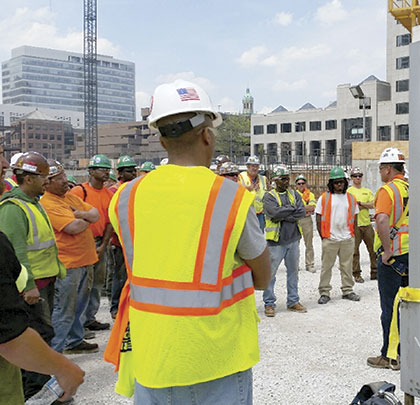According to a survey published in January 2016 by the Associated General Contractors of American and Sage Construction Real Estate, U.S. private and public sector construction markets are anticipated to grow in 2016, so will the challenges for finding skilled labor. While 71 percent of construction firms plan to expand headcount this year, 70 percent of those same firms report that it has been difficult to find salaried or craft professionals.
The lack of qualified workers—including those skilled in fall protection—has raised concerns that the construction industry will not be able to capitalize on this boom. This article will address the opportunity for safety managers to capitalize on the business boom, increase profits, and provide a safer working environment.
NEW TALENT
Due to increasing supply and demand issues with skilled and experienced tradesmen, managers are looking for a pool of new talent. One way employers are hoping to attract new, vested talent to the industry is with robust training programs. Nearly half of all respondents report that they plan to increase their investments in training and development this year. In a competitive market, the company that invests in its employee’s ongoing development and personal safety, and builds a culture that values its people, will thrive.
NEW HIRE ORIENTATION
For all workers at height, they cannot leave the ground until they’ve met OSHA and ANSI requirements in safety and equipment training. It’s common practice for employers to provide new hires with a basic orientation session that serves as a fundamental “first step” in the introduction of common jobsite hazards. This orientation will include a 4-hour basic safety briefing to satisfy OSHA’s and ANSI’s “authorized user” fall protection requirements. After checking fall protection off the orientation list, workers receive their hard hats and harnesses and start work.
While this 4-hour session does provide a solid introduction into fall protection, it does not guarantee that workers know how to use the equipment they’re given. Only hands-on experience can do that. Making this more problematic is the fact that nobody expects to fall, especially a new hire. As a result, they’re unprepared for the consequences of inadequate training. They simply don’t know what they don’t know.
Employers can maximize the overall safety of their team and make a good impression on new hires by offering a deeper, hands-on training session that engages participants and prepares them for possible dangers in the most effective way possible.

TRAINING COURSES: CONSIDERING YOUR OPTIONS
When employers are looking to train an influx of new employees, there are a few different approaches to consider: eLearning courses, one-on-one sessions with an on-site “Competent Person Trainer” (as outlined in OSHA standard), a basic authorized person course to meet standards, and more. No matter your approach, it’s important to be aware of two things:
1. On-site training offers invaluable learning and height safety protection for your team.
While companies including 3M Capital Safety, offer eLearning courses, it’s important to supplement these sessions with hands-on training to help ensure that all staff, new and old, understand the risks for working at height, and can adequately use the tools and solutions that are unique to their working environment.
2. When investing in new hire training courses, consider offering a refresher course to current workers.
At the start of every course, 3M Capital Safety trainers ask attendees to raise their hands if they have taken fall protection training in the past. Typically, about 90 percent raise their hands confidently and claim that yes, they know and understand fall protection dangers and safety equipment. As we get deeper into the course, it often becomes clear that a lot of what we’re presenting is new. Everyone from new hires to the old crew need to have a solid understanding of worker safety at height to make sure they are all committed to building safe habits and following the same regulations and standards on the job.
TRAINING LEVELS AND OPPORTUNITIES
Adequate fall protection training is as important as teaching a child to wash their hands. If a child doesn’t learn to wash their hands from a young age, they develop habits that could lead to illness. If a worker doesn’t understand and practice fall protection safety rules and regulations, they could fall. It’s far more expensive to treat a worker that has fallen than it is a child who catches a cold.
On my [Rick’s] first call to a construction site as a firefighter, a fall had occurred and the man involved was killed. I pulled back the tarp and noticed instantly that the man was wearing a harness. Why did he fall? I quickly discovered he was wearing adequate fall protection equipment as required, but didn’t know how to use it. The man who died neglected the importance of securing himself to a suitable anchor point.
To protect your crew from potential accidents and help them adopt good fall protection habits early on, consider the training levels and opportunities available. ■
Look for part two of this article in the next issue of MCS as the training levels and opportunities available are explained in detail.
About the Authors: Craig Firl is the North American technical manager and Rick Argudin is a senior trainer with 3M Capital Safety. For more information about fall protection training and resources, including technical links, videos, and open sessions, visit www.capitalsafety.com, or call 800.328.6146.
_________________________________________________________________________
Modern Contractor Solutions – May 2016
Did you enjoy this article?
Subscribe to the FREE Digital Edition of Modern Contractor Solutions magazine.

New Hires on the Rise in 2016: Fall Protection in the Growing Construction Industry: Part 1 of 2


